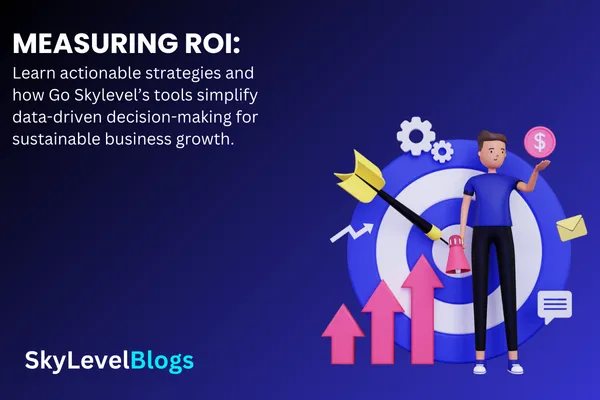
Measuring ROI: How SMBs Can Track Marketing Success
For small and medium-sized businesses (SMBs), every marketing dollar matters. Without properly tracking return on investment (ROI), businesses risk wasting resources on ineffective strategies. By measuring ROI accurately, SMBs can optimize their marketing efforts, increase profitability, and make data-driven decisions. Let’s explore how SMBs can measure marketing success effectively.
1. Define Your Marketing Goals
Before measuring ROI, businesses must establish clear marketing objectives. Common goals include:
Increasing brand awareness.
Generating high-quality leads.
Boosting sales and customer retention.
Improving engagement on digital platforms.
Setting specific, measurable goals ensures that marketing efforts align with the overall business objectives.
"Marketing without clear goals is like sailing without a compass—set your direction before tracking your progress."
2. Identify Key Performance Indicators (KPIs)
Tracking the right metrics is crucial for measuring marketing success. Key Performance Indicators (KPIs) vary based on your marketing objectives but may include:
Website Traffic: Measure unique visitors, page views, and session duration.
Lead Generation: Track form submissions, email sign-ups, and demo requests.
Conversion Rates: Monitor the percentage of leads that convert into paying customers.
Customer Acquisition Cost (CAC): Calculate how much it costs to acquire a new customer.
Customer Lifetime Value (CLV): Assess the long-term value of each customer acquired.
By identifying relevant KPIs, SMBs can determine which marketing channels are delivering the best results.
3. Calculate Marketing ROI
The simplest formula for calculating ROI is:
ROI = Net Income / Cost of Investment or ROI = Investment Gain / Investment Base
For example, if an SMB invests $5,000 in a campaign and generates $20,000 in revenue, the ROI would be:
A positive ROI indicates a profitable marketing strategy, while a negative ROI suggests adjustments are needed.
4. Use Analytics Tools for Data-Driven Decisions
Tracking ROI manually can be overwhelming. SMBs can leverage tools like Go Skylevel to:
Monitor Campaign Performance: Track metrics in real-time and adjust strategies accordingly.
Automate Data Collection: Integrate with CRM and marketing platforms for seamless reporting.
Generate Custom Reports: Access in-depth analytics on revenue attribution and customer insights.
With Go Skylevel’s automation and AI-driven insights, businesses can measure marketing success with accuracy.
"Data-driven decisions lead to smarter marketing investments and higher profitability."
5. Track Marketing Attribution
Marketing attribution helps SMBs understand which channels contribute most to conversions. Common attribution models include:
First-Touch Attribution: Credits the first interaction that led to conversion.
Last-Touch Attribution: Assigns credit to the final touchpoint before a sale.
Multi-Touch Attribution: Distributes credit across all customer interactions.
By analyzing attribution models, SMBs can allocate budgets to the most effective channels and optimize marketing spend.
6. Conduct A/B Testing to Improve ROI
Experimentation is key to improving marketing performance. SMBs can use A/B testing to compare:
Different ad creatives and messaging.
Landing page designs and call-to-action (CTA) buttons.
Email subject lines and content variations.
A/B testing helps businesses refine their strategies based on real performance data, ensuring higher conversion rates and better ROI.
7. Align Sales and Marketing Efforts
For maximum ROI, marketing and sales teams must work in sync. Go Skylevel’s CRM tools facilitate alignment by:
Tracking Lead Quality: Ensuring marketing generates high-intent leads.
Automating Lead Nurturing: Engaging prospects through personalized follow-ups.
Providing Sales Insights: Equipping teams with data on customer behavior and preferences.
When sales and marketing collaborate effectively, SMBs experience increased efficiency and revenue growth.
"A well-aligned sales and marketing strategy turns leads into lifelong customers."
8. Continuously Monitor and Adjust Strategies
Marketing success isn’t a one-time effort—it requires continuous analysis and optimization. Businesses should:
Regularly review performance reports.
Adapt to changing customer behaviors and market trends.
Test new strategies and refine underperforming ones.
By staying agile, SMBs can ensure long-term marketing effectiveness and sustained growth.
Maximize Marketing ROI with Go Skylevel
Measuring ROI is crucial to ensure that marketing efforts yield tangible results. Leveraging analytics, automation, and continuous optimization, SMBs can make smarter investments and drive consistent growth. Ready to track and improve your marketing ROI? Book a free discovery call with Go Skylevel today!
Connect with Us
Stay ahead with more tips and insights for SMB success. Follow us on social media:
